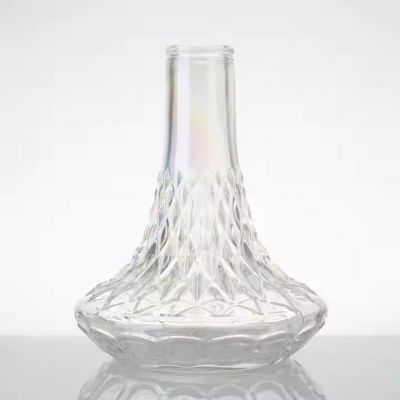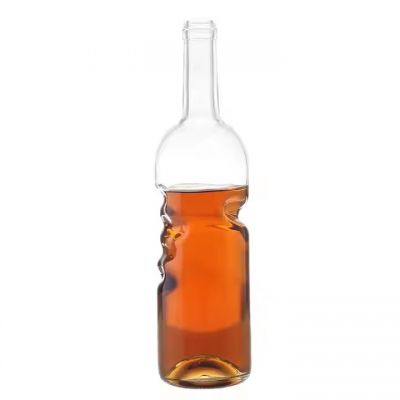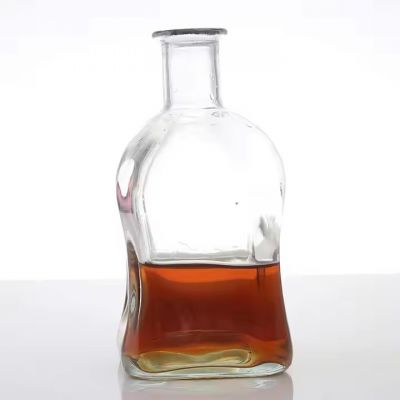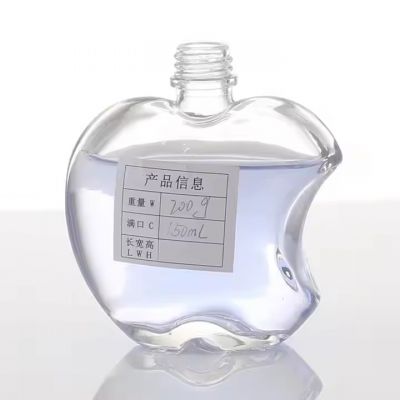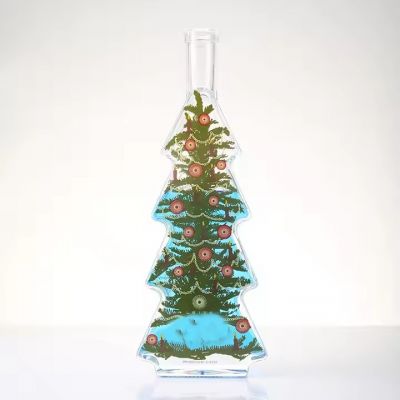Glass Bottles
There have been glass bottles in our country since ancient times. In the past, academic circles believed that glassware was very rare in ancient times, so it should only be owned and used by a few ruling classes. However, recent research suggests that ancient glassware is not difficult to produce and manufacture, but it is not easy to preserve, so it is rare in later generations. Glass bottle is a traditional beverage packaging container in our country, and glass is also a kind of packaging material with a long history. With many packaging materials pouring into the market, glass containers still occupy an important position in beverage packaging, which is inseparable from its packaging characteristics that other packaging materials cannot replace.
Glass bottle recycling The amount of glass bottle recycling is increasing every year, but the amount of recycling is huge and immeasurable.
According to the Glass Packaging Association, the energy saved by recycling a glass bottle can light up a 100-watt bulb for about 4 hours, run a computer for 30 minutes, and watch TV programs for 20 minutes. Therefore, recycling glass is A matter of great significance.
Glass bottle recycling saves energy and reduces the waste capacity of landfills, which can provide more raw materials for other products, including glass bottles of course. According to the National Consumer Plastic Bottle Report of the Chemical Products Council of the United States, approximately 2.5 billion pounds of plastic bottles were recycled in 2009, with a recycling rate of only 28%.
Glass containers began to appear in the Han Dynasty. For example, a glass plate with a diameter of more than 19 cm and a glass ear cup with a length of 13.5 cm and a width of 10.6 cm were unearthed from the Tomb of Liu Sheng in Mancheng, Hebei. During the Han Dynasty, the traffic between China and the West was developed, and foreign glass would be introduced to China. Three pieces of purple and white glass fragments were unearthed from an Eastern Han tomb in Qiongjiang County, Jiangsu Province. After restoration, they were a flat-bottomed bowl with raised ribs. The shape of the vessel and the technique of stirring the tire are all typical Roman glassware, which is the physical evidence of the introduction of Western glass into China. In addition, the tomb of the Nanyue King in Guangzhou has also unearthed blue plate glass ornaments, which is unprecedented in other places in China.
During the Wei, Jin, Southern and Northern Dynasties, a large number of Western glassware was imported into China, and the technology of glass blowing was also introduced. Due to the innovative changes in composition and technology, the glass container at this time is larger, the wall is thinner, and transparent and smooth. Convex glass lenses were also unearthed from the clan tombs of Cao Cao in Bo County, Anhui Province; glass bottles were unearthed from the tower base of the Pagoda of the Northern Wei Dynasty in Dingxian County, Hebei; and a lot of ground glass cups were also unearthed from the Tombs of Xiangshan, Shandong, Nanjing, Jiangsu. The most exciting is the glassware unearthed from the tomb of Sui Li Jingxun in Xi'an, Shaanxi. There are 8 glassware, including flat bottles, round bottles, boxes, egg-shaped vessels, tube-shaped vessels and cups, all intact.
In the Eastern Zhou Dynasty, the shape of glass objects increased. In addition to ornaments such as pipes and beads, bi-shaped objects and sword pipes, swords, and swords were also found; glass seals were also unearthed in Sichuan and Hunan. The glassware at this time has a pure texture and color
Single handle melon-shaped glass bottle (Tang)
Single handle melon-shaped glass bottle (Tang)
White, light green, milky yellow and blue, etc.; some glass beads are also colored to form dragonfly eyes. For example, seventy-three dragonfly-eye glass beads were unearthed from the tomb of Zenghouyi in Suixian County, Hubei Province, each with a diameter of about one centimeter. There are white and brown glass patterns on the blue glass sphere. The academic circles have analyzed the composition of glass beads and glass walls in the middle and late Warring States period and found that these glassware are mostly composed of lead oxide and barium oxide, which are different from the ancient glass in Europe, West Asia, and North Africa. Therefore, the academic community believes that they may be Made in China.
The spraying production line of glass bottles generally consists of a spray booth, a hanging chain and an oven. There is also the front-end water treatment for glass bottles, and special attention to the problem of sewage discharge is for glass bottles. As for the spraying quality of the glass bottle, it is related to the water treatment, the surface cleaning of the workpiece, the electrical conductivity of the hook, the size of the air volume, the amount of powder spraying, and the level of the operator. It is recommended to choose the following method for trial: pre-treatment section
The pre-treatment section of glass bottle spraying includes pre-off, main off, surface adjustment, etc. If it is in the north, the temperature of the main off part should not be too low, and heat preservation is required. Otherwise, the treatment effect is not ideal;
Preheating section
After pre-treatment, it must enter the preheating section, which generally takes 8-10 minutes. It is best to make the sprayed workpiece have a certain amount of residual heat when the glass bottle reaches the powder spraying room, so as to increase the adhesion of the powder;
The main characteristics of glass packaging containers are: non-toxic, tasteless; transparent, beautiful, good barrier properties, airtight, abundant raw materials, low price, and can be used in multiple cycles. And it has the advantages of heat resistance, pressure resistance, and cleaning resistance. It can be sterilized at high temperature and can be stored at low temperature. It is precisely because of its many advantages that it has become the preferred packaging material for many beverages such as beer, fruit tea, and jujube juice.
71% of the world’s beer is bottled in glass beer bottles, and China is also the country with the highest proportion of glass beer bottles in the world, accounting for 55% of the world’s glass beer bottles. There are more than 50 billion glass beer bottles each year. Glass beer bottles are used as beer packaging. Mainstream packaging has gone through a hundred years of vicissitudes of beer packaging. It is still favored by the beer industry due to its stable material structure, non-polluting, and low price. The glass bottle is the first choice for packaging. Generally speaking, the glass bottle is still the usual packaging of beer companies. "It has made a great contribution to beer packaging, and most people like to use it.
The Glass Bottle Museum is located in the northern part of the Sukhumvit (Sukhumvit) highway bypass on the southern part of the eastern side of Pattaya, Thailand. This museum was founded by Mr. Bjj De Leij, a Dutch national.
This is an inconspicuous glass bottle art museum. The museum has a collection of more than 300 rare and beautiful shapes.
Many famous buildings inside, such as Wat Phra Kaew in Bangkok, Wat Arun, Marble Temple, Victory Monument, Democratic Constitution Monument, and even Thai temples, are all built in glass bottles, and they are built in such a decent size and perfection. , Such a beautiful and magnificent typical building is built in a small glass bottle in the mouth. It is conceivable how much effort and time it takes for such an artistically beautiful building to be concentrated in glass bottles. Its hard work and time are comparable to the difficulty of building a real place of interest.
Glass products are made of more than ten kinds of raw materials such as broken glass, soda ash, sodium nitrate, barium carbonate, quartz sand, etc., a container made by processes such as melting and shaping at a high temperature of 1600 degrees, which can be produced in different shapes according to different molds The glass bottles mainly include various special-shaped glasses such as wine bottles, beverage bottles, pickle bottles, honey bottles, canned bottles, soda bottles, carbonated beverage bottles, coffee bottles, tea cups, 0.5kg/2.5kg/4kg wine jars, etc. bottle,. The glass bottle is sealed and light-transmissive, which can store products that are highly sensitive to humidity for a long time.
The glass bottle production process mainly includes: ①Pre-processing of raw materials. Crush the bulk raw materials (quartz sand, soda ash, limestone, feldspar, etc.) to dry the wet raw materials, and remove iron from the iron-containing raw materials to ensure the quality of the glass. ② Preparation of batch materials. ③Melting. The glass batch material is heated at a high temperature (1550~1600 degrees) in a pool furnace or a pool furnace to form a uniform, bubble-free liquid glass that meets the molding requirements. ④Forming. Put the liquid glass into the mold to make glass products of the required shape, such as flat plates, various utensils, etc. ⑤ Heat treatment. Through annealing, quenching and other processes, the internal stress, phase separation or crystallization of the glass is eliminated or generated, and the structural state of the glass is changed.
Field advantages
The advantages of glass packaging containers in the field of beverage packaging
Glass bottle
Glass bottle
Glass packaging materials and containers have many advantages: 1. Glass materials have good barrier properties, which can prevent oxygen and other gases from attacking the contents, and at the same time prevent the volatile components of the contents from volatilizing into the atmosphere;
2. The glass bottle can be used repeatedly, which can reduce the packaging cost;
3. The color and transparency of glass can be changed easily;
4. The glass bottle is safe and hygienic, has good corrosion resistance and acid corrosion resistance, and is suitable for packaging acidic substances (such as vegetable juice drinks, etc.);
5. In addition, because glass bottles are suitable for the production of automatic filling production lines, the development of domestic glass bottle automatic filling technology and equipment is also relatively mature, and the use of glass bottles to package fruit and vegetable juice beverages has certain production advantages in China.
Production Process
Essential oil bottle
Essential oil bottle
First of all, the mold must be designed, determined and manufactured. The glass material is made of quartz sand as the main raw material, and other auxiliary materials are melted into a liquid state at high temperature, and then injected into the mold, cooled, cut, and tempered to form a glass bottle. Glass bottles generally have a rigid logo, and the logo is also made of a mold shape. According to the manufacturing method, the molding of glass bottles can be divided into three types: manual blowing, mechanical blowing and extrusion molding. Glass bottles can be divided into the following types according to their composition: one is soda glass, the other is lead glass, and the third is borosilicate glass.
The main raw materials of glass bottles are natural ore, quartz stone, caustic soda, limestone and so on. The glass bottle has a high degree of transparency and corrosion resistance, and the material properties will not change in contact with most chemicals. The manufacturing process is simple, the shape is free and changeable, the hardness is large, heat-resistant, clean, easy to clean, and can be used repeatedly. As packaging materials, glass bottles are mainly used for food, oil, wine, beverages, condiments, cosmetics and liquid chemical products, etc., with a wide range of uses. However, glass bottles also have their disadvantages, such as large weight, high transportation and storage costs, and inability to withstand impact.
Use characteristics and types of glass bottles: Glass bottles are the main packaging containers in the food, medicine, and chemical industries. They have good chemical stability; easy to seal, good airtightness, and transparency, and the condition of the contents can be observed from the outside; good storage performance; smooth surface, easy to disinfect and sterilize; beautiful appearance, colorful decoration; certain machinery Strength, can withstand the pressure in the bottle and external force during transportation; the advantages of wide distribution of raw materials and low price. Its disadvantages are high quality (large ratio of mass to capacity), high brittleness, and fragility. However, these shortcomings have been significantly improved by adopting the new technology of thin-wall, light-weight and physical and chemical tempering. Therefore, the output of glass bottles can increase year by year under the fierce competition with plastics, iron cans, and iron cans.
There are many varieties of glass bottles, from small bottles with a capacity of 1ML to large bottles of more than ten liters, from round, square, to special-shaped and handle bottles, from colorless and transparent amber, green, blue, black shading bottles and opaque The opalescent glass bottles, etc., are too numerous to mention. In terms of manufacturing process, glass bottles are generally divided into two categories: molded bottles (using model bottles) and control bottles (using glass control bottles). Molded bottles are divided into two types: large mouth bottles (bottle mouth diameter above 30mm) and small mouth bottles. The former is used to hold powder, block and paste-like objects, and the latter is used to hold liquids. According to the form of the bottle mouth, it is divided into cork bottle mouth, screw bottle mouth, crown cap bottle mouth, rolling bottle mouth frosted bottle mouth, etc. According to the usage, it is divided into "one-time bottles" that are discarded after use once and "recycled bottles" that are used in multiple cycles. According to the classification of the contents, it can be divided into wine bottles, beverage bottles, oil bottles, canned bottles, acid bottles, medicine bottles, reagent bottles, infusion bottles, cosmetic bottles and so on.

